Culinary Bridges
The perfect guide for the common cuisine between Greece and Türkiye.

 DAMLA CEYDA UZUN | ANDRIANA
DIAMANTIDOU | PAOLINA ELEZI |
DAMLA CEYDA UZUN | ANDRIANA
DIAMANTIDOU | PAOLINA ELEZI |




 DAMLA CEYDA UZUN | ANDRIANA
DIAMANTIDOU | PAOLINA ELEZI |
DAMLA CEYDA UZUN | ANDRIANA
DIAMANTIDOU | PAOLINA ELEZI |


The perfect guide for the common cuisine between Greece and Türkiye.
"Food is a pretty good prism through which to view humanity"
Johnathan Gold
Mezes ...7
Tzatziki
Dolma yalanci
Eggplant salad (patlican ezmesi)
Tarama (Fish roe salad dip)
Zucchini balls
Main dishes ...20
Karniyarik (Papoutsakia)
Fasolakia ladera (Taze fasulye)
Stuffed vegetables (Dolmas)
İzmir köfte
Manti
Deserts ...39
Kazan Dibi
Tulumba
Baklava
Ravani
Galaktoboureko
Turkish Tea Time ...52
Preparing Çay
Sigara Böregi
Sekerpare
Börek
Tuzlu Kurabiye
Final words ...63
Greece and Turkey have a long connected history, that we can still observe through their common gastronomy. The two cuisines exhibit a mixture of Eastern and Western elements.
Especially, after the population exchange in 1923 the people who arrived in Greece, upgraded the plain cuisine of the mainland Greece, adding to it a little bit of spice. The food that the refugees brought, mostly kept their original Turkish names. That's why the Greeks still use the "politiki" cuisine term, meaning the cuisine of Istanbul.
Besides providing delicious recipes, this book intends to share some facts about history and culture of these two nations by looking at the tradition of some recipes. Enjoy!

"While eating your appetizer, don't be concerned with the dessert."
Wayne Dyer
The meze, derived from the Persian word " mazze, " meaning taste or appetizer, is particularly popular in Greece, Türkiye, and other countries in Middle East. The term meze refers to small dishes that are usually accompanied by traditional alcoholic beverages such as ouzo, raki, and wine, or as additions to the main dish, adding a variety of flavors and sensations.
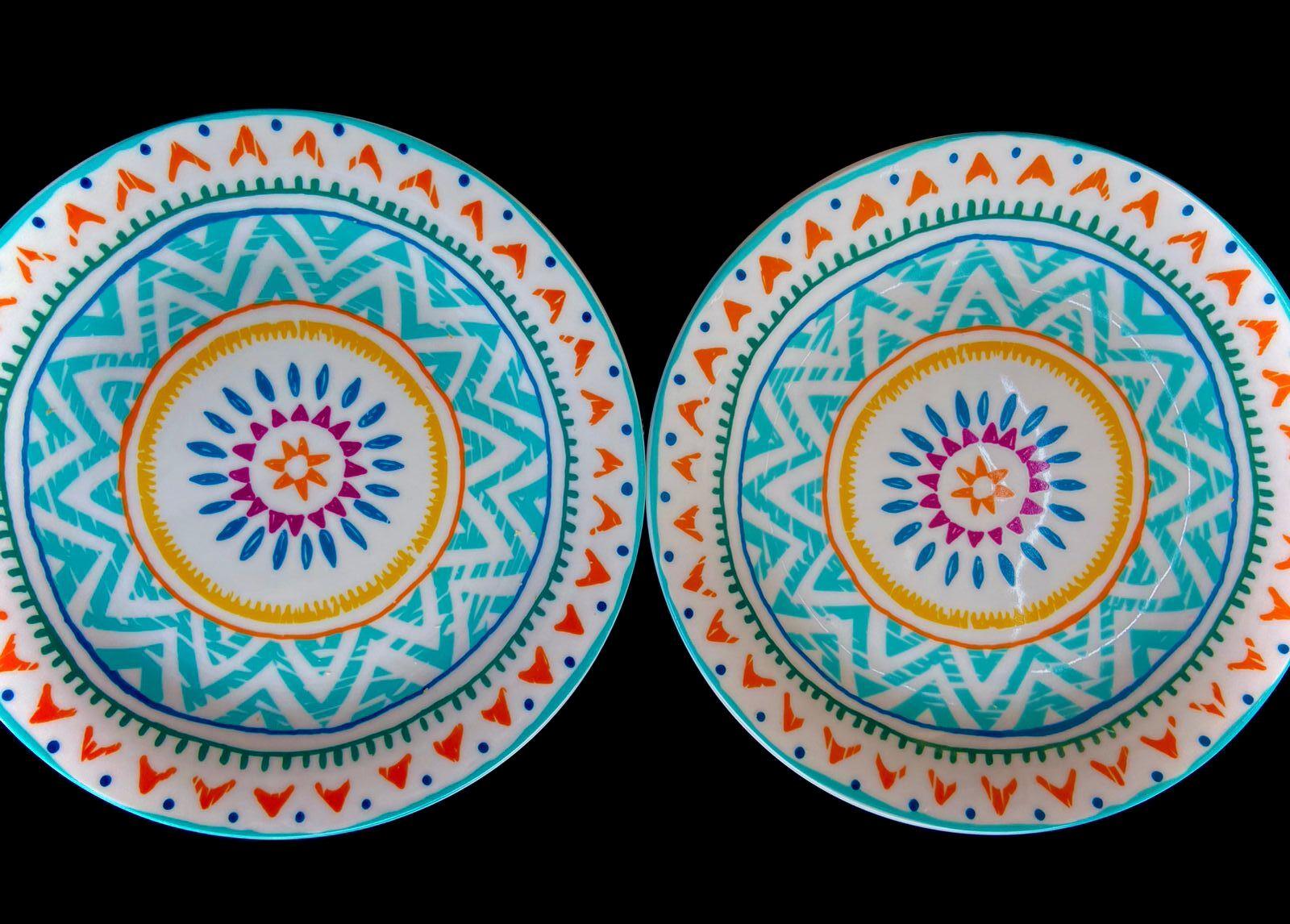

300 gr. strained yogurt
1 cucumber
1/3 garlic clove
3 ts vinegar
1/4 bunch of dill (optional)
2 ts olive oil
1 pinch of salt
peper
Peel and grate the cucumber.
Put it in a towel with the salt and the vinegar and drain.
Add in a bowl the yogurt and the cucumber with other 2 ts of vinegar.
Chop the garlic and the dill.
Add them and the rest of the ingredients to the bowl.
Mix well and serve cold.
*In Turkey they also add some water, to make it less thick.

1 cup rice
1/2 cup olive oil
1 onion, finely chopped
1/4 cup pine nuts
1/4 cup chopped fresh parsley
1/4 cup chopped fresh mint
1 teaspoon dried mint
1 teaspoon ground cumin
1 teaspoon ground cinnamon
Salt and pepper to taste
12-15 vine leaves (fresh or preserved)
1 lemon, sliced
Rinse the rice thoroughly in cold water and drain.
Heat the olive oil in a large skillet over medium heat. Add the chopped onion and cook until it becomes translucent and soft.
Add the pine nuts to the skillet and cook for a few minutes until they turn golden brown.
Stir in the rice, parsley, fresh mint, dried mint, cumin, cinnamon, salt, and pepper. Cook for about 5 minutes, stirring frequently, until the rice is well coated with the spices.
Remove the skillet from the heat and set it aside to cool for a few minutes.
If you ' re using fresh vine leaves, put them in boiling water for a few minutes until they become soft and pliable. If you ' re using preserved vine leaves, rinse them thoroughly to remove any excess salt.
Take a vine leaf and place it shiny side down on a flat surface. Trim off the stem if necessary. Put about a tablespoon of the rice mixture onto the centre of the leaf.
Fold the sides of the leaf over the rice mixture, then roll it up tightly from the bottom to the top. Repeat this process with the remaining vine leaves and rice mixture. Line the bottom of a large pot with a few unused vine leaves to prevent the dolmas from sticking. Arrange the dolmas in a single layer in the pot, placing them closely together.
Place a few lemon slices on top of the dolmas. This will help prevent them from unravelling during cooking.
Pour enough water into the pot to cover the dolmas completely. Place a heatproof plate on top of the dolmas to prevent them from moving while cooking.
Bring the water to a boil over high heat, then reduce the heat to low and cover the pot. Simmer for about 30-40 minutes or until the rice is fully cooked and tender. Once cooked, remove the dolmas from the pot and let them cool for a few minutes. Serve warm or at room temperature.
*Dolmas with rice are called “yalanci”, a turkish word that means fake, that’s because they don’t have any meat. According to turkish tradition the real dolmas is the one with the meat and they are most commonly called " sarmas " which means rolled

6 eggplants
1-2 garlic cloves
1/4 coups of olive oil
1/2 lemon juice
2-3 tbsp. wine vinegar
Salt
Freshly ground pepper
2 tbsp. chopped parsley
Grill the eggplants on the kitchen grill for 10 minutes on each side (the skin must be burnt to get the smokey smell).
Peel them immediately.
Put them in a colander and drain their liquids.
Chop the roasted eggplant and put it in a bowl.
Add the olive oil, garlic, lemon, vinegar, parsley, salt and pepper and mix.
Put the eggplant salad in the refrigerator.
*The story of the eggplant salad comes form a Syrian woman and the care she provided for her elderly father, who could not chew his food and his daughter was forced to grind all the food.
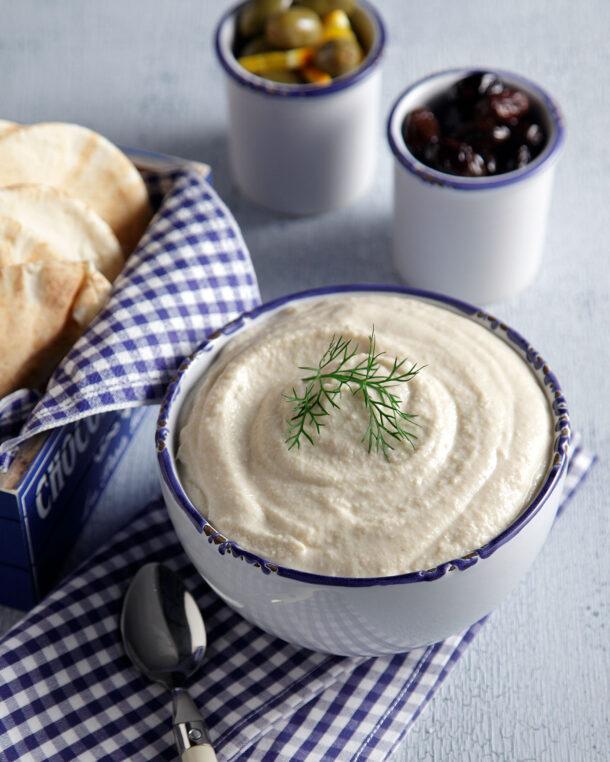
120 gr. white tarama (fish roe)
200 gr. stale bread, without the crust, soaked in water and well squeezed
80 ml lemon juice
300 - 350 ml olive oil
1 small dry onion, grated
Put the onion in a fine strainer, press it to remove all the liquid and pour it into the food processor. Add the tarama, bread and juice and beat on high speed for 1 minute. Add the oil.
Keep mixing until you have a cream with mayonnaise texture.
*The origin of the word tarama, is an expression used by Turks for fish eggs. Tarama is fish eggs, usually carp or cod, which are also the raw material to make tarama salad.

1 kg zucchinis
2 eggs
250 gr. crumbled feta
1/2 bunch chopped dill
1/2 bunch chopped parsley
100 gr. flour
50 gr. self raising flour of olive oil salt pepper
Rub the pumpkins on the grater and squeeze very well. Put them in the strainer, add salt and leave them for about 10 minutes to drain completely.
In a large bowl, put the grated Pumpkins, eggs, feta cheese, both types of flour, dill, parsley, salt and pepper and mix well.
Shape the meatballs and press them lightly before flouring them. Pour olive oil into a large pan and wait for it to burn. put the meatballs in for 2-3 minutes and turn them until they get color on both sides.
Take them out with a slotted spoon and place them on a plate lined with paper to absorb the oil.
"Food is our common ground, a universal experience "
James Beard

Eggplants
4-5 eggplants
½ tea cup of olive oil or 3 tbsp of olive oil
2 tbsp thyme
Salt and pepper
1 clove of garlic
One and a half onion
50gr cheese, grated
250gr ground beef
40gr red wine
400gr canned tomatoes
1 bunch parsley
1 tbsp mint
2 tbsp flour
2 tbsp butter 1/2 lt fresh milk
1 egg
Salt Pepper
2 pinches of nutmeg
1 cup cheese grated
For the eggplants
Preheat oven to 200C.
Cut the eggplants in half & remove the stems.
Add 3 tablespoons of olive oil, salt, pepper and thyme. Spread them over the surface of the eggplants with your hands.
Line a baking pan with parchment paper and add eggplants cut side down.
Bake for 30-40 minutes, until they soften. When they are ready, remove them from oven and transfer them to an oven proof baking dish, skin side down.
Press down on the flesh to create an “indentation” to add the ground meat filling
For the ground meat mixture:
Place a pan over high heat. Add 1 and a half tablespoon of olive oil and let it get very hot.
Cut the onion and the garlic and add them to the pan. Add thyme, salt, pepper and cloves.
Mix them for 5 minutes, then add the ground meat and mix it for 2-3 minutes.
Add the wine and wait until the alcohol evaporates.
Add 2 tomatoes and let it cook for 15 minutes.
Remove it from the heat and wait until its cold.
Add the cheesse, parsley, thyme and mint, mix them and fill the eggplants with a spoon. For the béchamel
Melt the butter in a saucepan and add the flour.
Mix for 2' and add the milk little by little.
Add salt and pepper.
Grind the nutmeg, stirring constantly until it becomes a thick smooth cream.
Remove from the fire.
Add the egg and half the cheese.
Mix with quick movements.
When everything is ready, put the ground meat in the eggplants.
Then add the béchamel over the ground meat and the eggplants
Put them in the oven
Wait for 30-40 minutes until the béchamel is golden
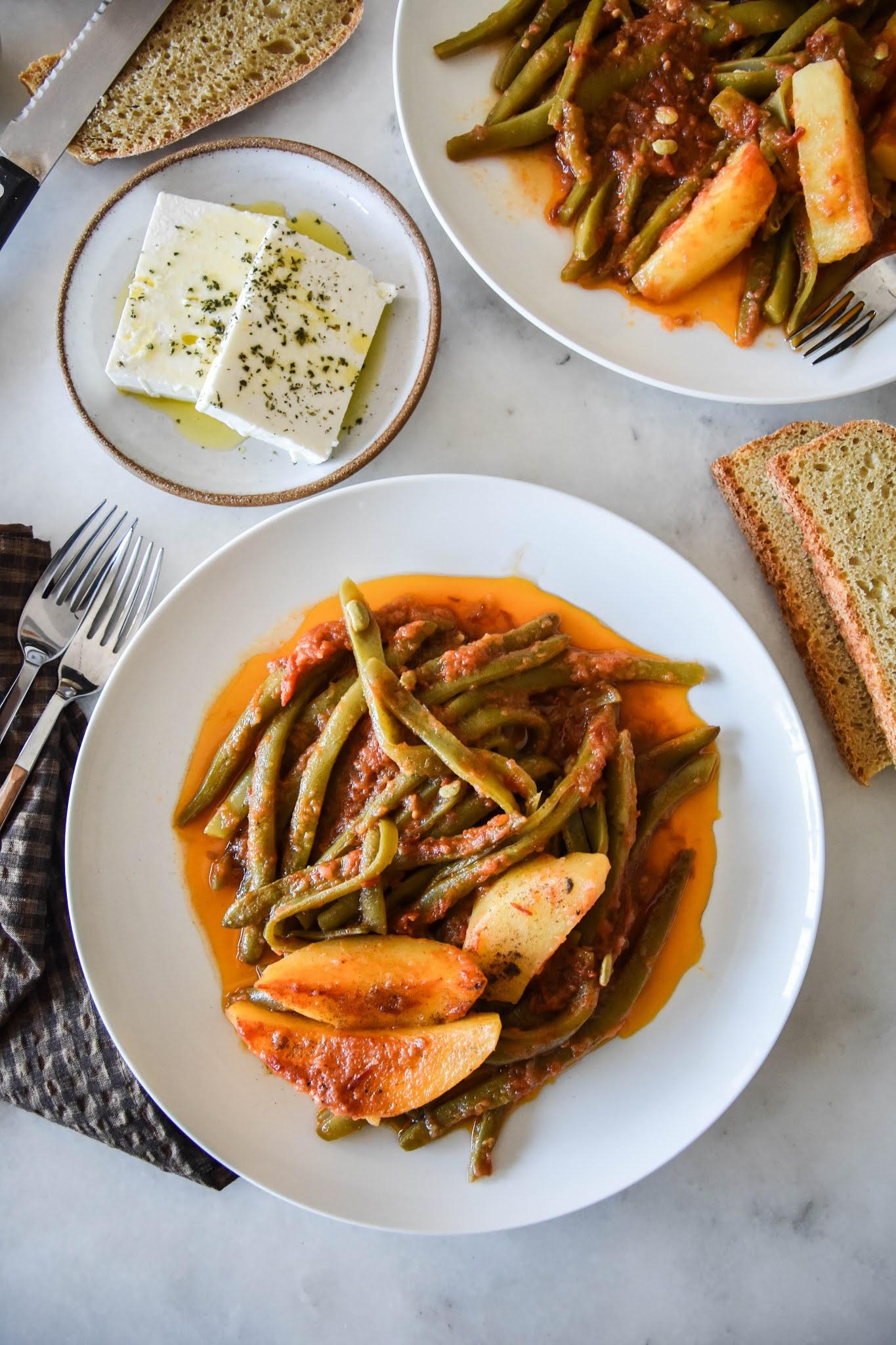
1 onion
100 gr olive oil
1 clove of garlic
1 tsp granulated sugar
500 gr potatoes
1 tbsp tomato paste
50 gr white wine
lemon zest, of 1 lemon
400 gr canned tomatoes
300 gr water
1 kilo green beans, fresh or forzen
1/3 bunch mint
2 spring onions
1/3 bunch parsley
salt, pepper
Place a pot over high heat and add 2 tablespoons olive oil.
Coarsely chop the onion and add to the pot. Mince the garlic and add it to the pot along with the sugar. Sauté until the onion softens.
Peel the potatoes, cut them into pieces and add them to the pot.
Add the tomato paste and wine. Mix until the alcohol evaporates.
Add the lemon zest, chopped tomatoes and water.
Chop the edges off of the green beans, add them to the pot and mix.
Cover pot with lid, lower heat to medium-low and simmer for 40-50 minutes.
Remove pot from heat and add the mint, parsley, the green part of the spring onions finely chopped, salt, pepper and olive oil. Mix and serve
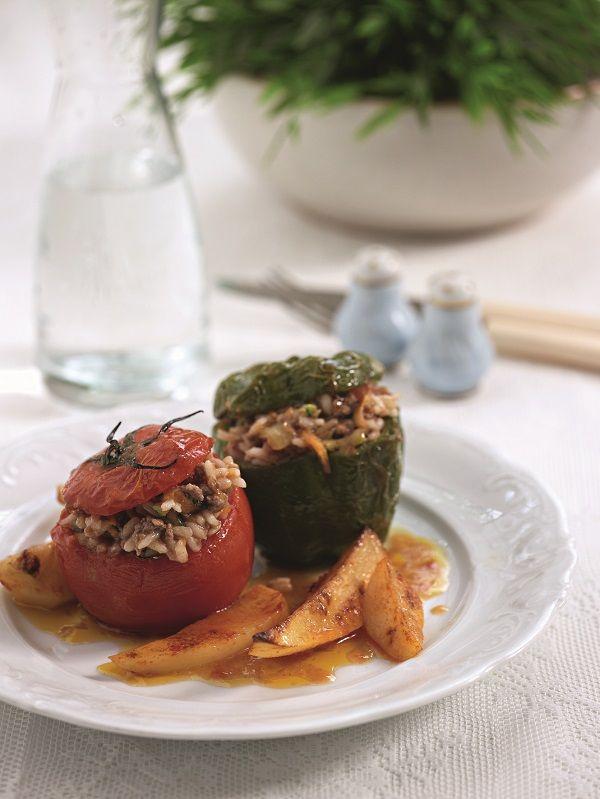
6 medium-sized tomatoes
4 medium-sized bell peppers
2 large onions, finely chopped
3 garlic cloves, minced
500g minced meat (beef or pork)
1 cup rice
1/4 cup olive oil
1/4 cup fresh parsley, chopped
1/4 cup fresh mint, chopped
1/4 cup fresh dill, chopped
1 can crushed tomatoes or tomato
sauce
Salt and pepper to taste
STEPS
Preheat your oven to 180°C.
Prepare the vegetables: Cut off the tops of the tomatoes and peppers and scoop out the insides carefully, creating hollow shells. Keep the flesh of the tomatoes to use them later.
In a large pan, heat 2 tablespoons of olive oil over medium heat. Add the chopped onions and minced garlic, and sauté until they become translucent. Add the minced meat to the pan and cook until it browns, breaking it up into smaller pieces with a spatula as it cooks.
Stir in the rice and cook for a few minutes until it gets coated with the meat and onion mixture. Add the chopped parsley, mint, and dill to the pan, mixing everything together.
Season the mixture with salt and pepper according to your taste.
Take the reserved tomato flesh and seeds and chop them finely. Add them to the pan, along with the crushed tomatoes or tomato sauce. Cook for another 2-3 minutes, allowing the flavors to meld. Grease a large baking dish with the remaining olive oil. Place the hollowed-out tomatoes and peppers in the dish.
Carefully stuff each tomato and pepper with the meat and rice mixture, making sure not to overstuff them as the rice will expand during cooking.
Pour the vegetable or chicken broth into the bottom of the baking dish to keep the gemista moist during baking.
Place the baking dish in the preheated oven and bake for approximately 50-60 minutes or until the vegetables are tender and the rice is cooked. Serve the gemista warm, optionally drizzled with some extra olive oil.
*While in the turkish cuisine the term dolma refers to stuffed vegetables, like tomatoes, peppers, eggplants, zucchinis, etc, in Greece it is used only for rolled vine leaves.
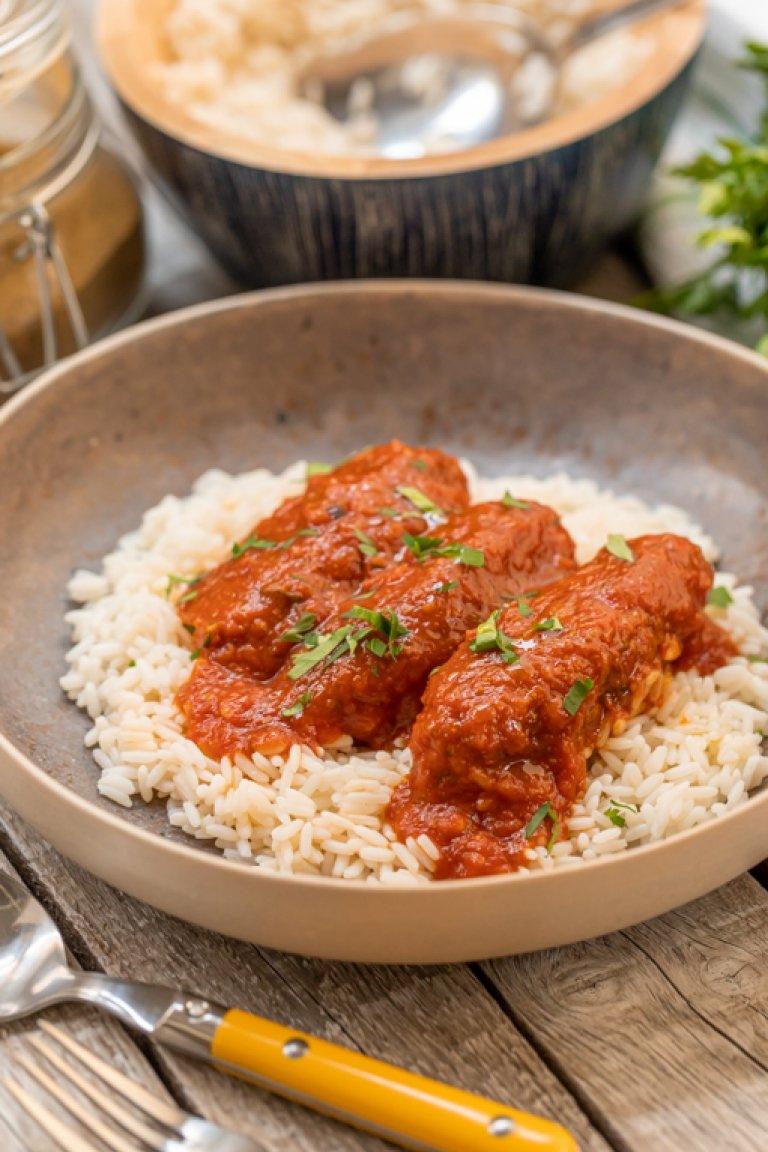
Meatballs
50 ml olive oil
2 garlic cloves
250 gr. ground beef
250 gr. minced pork
200 gr. bread for toast
100 ml whole milk
1 egg salt
1 pinch of bukovo
1 1/2 tbsp. cumin
1 pinch of pepper
mint
20 ml of ouzo
Tomato sauce
1 tbsp olive oil
1 onion, medium
1 tbsp tomato paste
2 bay leaves
250 ml of water
1 chicken cube
400 gr. tomato concache
1/2 tsp. sugar
1 cinnamon stick
100 gr. wheat flour, for breading
50 ml seed oil, for frying
Meatballs preparation
Beat the oil and garlic in the mixer.
Pour the oil with the garlic, milk, ouzo and egg into a large bowl.
Stir with the whisk.
Add the bread in pieces, the cumin, the cumin and the chopped mint.
Mix very well with your hands until the bread is completely melted.
Add to the mixture enough salt and pepper and the two minced meats.
Stir until our mixture is homogeneous.
In a baking tray with flour, shape our soujukaki into an oval shape and place them on the baking tray. (about 30-50g each)
Turn the suzukaki so that the flour gets everywhere.
Put a non-stick pan on a medium to high heat, add seed oil and wait 1 minute for it to burn.
We remove the extra flour, shaping by hand and place our suzukas one by one in the pan.
Fry our suzukas until they get colored on all sides. (for about 5 minutes)
We transfer our suzukas to a pan or a plate on which we have placed kitchen paper to drain the excess oil.
Set aside.
Tomato sauce preparation
Put a saucepan on medium heat.
Chop an onion.
Pour some olive oil into the pot and add the onion.
Add the sugar and mix.
Wait until the onion caramelizes.
Once caramelized, add 1 tbsp. full of tomato paste and saute well for at least 1-2 minutes to set the sauce.
Add cinnamon, bay leaves, 1 cube, tomato and water.
Mix a little and throw in the mixture.
Cover and cook on low heat for 10 minutes for the sauce to set and the meatballs to be ready.
We serve our soutzoukakia with basmati rice and fresh mint!
*The recipe has its roots in the Ottoman Empire. The refugees from Asia Minor and Istanbul brought this recipe to Greece. In Turkey, they refer to the recipe as kofte (meatball), which is the homemade version of sucuk (sausage) with tomato sauce and spices.
In Greece, it is called σουτζουκάκια (little sucuk). Greeks often use bukovo (crushed red chili peppers) to make it spicy.

The dough
3 glasses of flour (200 ml)
1 glass of warm water
1 egg
1 tea spoon of salt
The sauce
200 ml of yoghurt
a pinch of mint
a pinch of paprika powder
Stuffing
250 gr of minced meat
1 onion
1 tea spoon of salt
a pinch of pepper
a pinch of paprika powder
The garnish
1125 gr of butter
2 spoons of tomato paste
Steps
Begin with the dough. Take a bowl and mix the flour, the salt and the egg together. Little by Little add the water to the mass and work them together until the dough is not sticky anymore. Take the mined meat, grate the onion and mix them. Add all the other ingredients and mix them again.
Take thedough and divide it into small pieces. Roll them with a rolling pin until the dough is very thin. Take a knife and cut the pastry into little squares. Put a bit of the stuffing on each little square Close them in the form of an triangle or put each corner into the middle. Put water into a pot and let them boil for at least 20 minutes.
For the sauce, mix all ingredients together. Put the butter into a pan and add the tomato pauce after the butter is hot. Keep it until it is a homogenous mixture.
Put the mantis onto the plate and put the yogurt suace on them. Garnish the Mantis with the tomato sauce.
"Never forget, stressed spelled backwards is desserts "

1 liter of buffalo milk
2 tbsp flour
2 tbsp cornstarch or cornflour
2 tbsp rice flour
1 cup of sugar
Some powdered sugar for the oven pan
Some butter for the oven pan
Cinnamon to your liking
Grease an oven pan with butter and sprinkle powdered sugar over it.
Mix in a bowl the flour, cornstarch and rice flour with a little milk.
Place the remaining milk and sugar in a saucepan and let it come to a boil. Take a spoonful of the hot milk and pour it into the bowl with the other ingredients, stirring them together. Continue pouring this mixture into the saucepan with the hot milk and cook over medium heat, stirring constantly to prevent sticking until it thickens into a cream.
Place the buttered pan on the stove. Pour a large spoonful of the cream into it and let it cook over medium heat until it starts to burn. Check by flipping it with a spoon at the edge. Once it starts to burn, remove it from the heat and add the rest of the cream to the baking dish, then continue cooking until it comes to a boil.
After it cools down put it in the refrigerator for 1 hour. Cut it into slices and roll them up. Be careful not to make the rolls too long. Serve with the burnt side up and if desired sprinkle with a little cinnamon.
*Kazan Dibi is a recipe with Minor Asian roots. In turkish it means bottom of the cauldron. In Greece cow milk is most commonly used.

For the water
2 glasses of water
2,5 glasses of flour
1 spoon of butter or margarine
1 tea spoon of sugar
a pinch of salt
3 eggs
3 spoons of semolina
1 spoon of lemon juice
oil (for frying)
For the Syrup
3 glasses of sugar
3 glasses of water
2 spoons of lemon juice
Equipment:
pastry bag
Begin with the syrup. Put all ingredients in a pot and keep it boiling for 30-35 minutes. Then, let it cool down and put it into the fridge. For the dough, fill the pot with the water, the butter, the sugar and the salt and let it boil. Strain the flower and fold it into the mass. Cook the dough for a while. Let it cool down afterwards. Add the eggs step by step and mix theminto the mass. Keep mixing the dough for 2 minutes after adding each egg. Take another pot and fill it with the oil for frying. Fill the pastry bag with dough and put little pieces of the dough into the oil. Wait until the pieces are golden and crispy. Put the freshly fried Tulumba pieces into the cold syrup and start serving them.

200g butter, plus extra for greasing 200g pistachios
50g walnuts
50g pecans
3 tbsp honey
2 x 270g pack filo pastry
For the syrup
250g golden caster sugar
50g honey
2 tsp orange blossom water
½ tsp ground cinnamon
¼ tsp ground cardamom (from 3 pods)
Heat the oven to 180C/160C fan and grease a 21cm x 21cm square cake tin with butter.
Chop the nuts into small pieces using a food processor, taking care not to blitz them to a paste. Put them into a bowl, stir in the honey and a pinch of salt and set aside.
Melt the butter in a pan over a low heat. Cut the first pack of filo pastry sheets in half (so that they fit the tin). Put one sheet in the tin and brush with the melted butter. Lay another sheet on top and brush with butter again, keep layering like this until the whole pack is used up.
Spread the honey and nut mixture over the pastry and press it down lightly with the back of a spoon.
Open the other pack of filo, cut in half and continue the layering and buttering process. When you reach the last sheet pour any remaining butter over the top to finish. Use a sharp knife to cut deep lines into the pastry to create either squares or diamond shapes then bake in the oven for 20 mins.
Reduce the heat to 150C/130C fan and bake for a further 45 mins.
While the baklava cooks put all the syrup ingredients into a saucepan and add 200ml water.
Heat gently until the sugar has dissolved then boil the mixture for 8-10 mins or until it has reduced to the consistency of runny honey.
When the baklava comes out of the oven, pour the warm syrup over the top, allowing it to run into the lines you have cut. Leave it to soak in and serve when it’s completely cold
*Food historians think modern baklava may have been invented in Turkey during the Ottoman Empire, then modified in Greece. However, the technique of layering unleavened bread with nuts and honey can be traced back as far as the 8th century B.C.E. during the Assyrian Empire.

For the syrup
900 ml water
1200 gr granulated sugar
2 tbsp honey
lemon peel of 1 lemon
1 stick of cinnamon
For the cake
215 gr granulated sugar
1 1/2 gr mastic
8 eggs
1 tsp vanilla extract
250 gr butter, melted
200 gr semolina
200 gr soft flour
2 tbsp baking powder
lemon zest of 1/2 lemon
For the syrup
Place a pot over medium to high heat.
Add the water, sugar, lemon rind and cinnamon stick.
Bring to a boil and as soon as the sugar melts completely, remove from heat.
Add the honey, stir and set aside to cool completely before pouring over cake.
The honey is added at the end so that it will not lose its aroma from boiling.
For the cake
Preheat oven to 180* C /350* F fan.
Beat 15 g of the sugar (from the 215 g) and the mastic in a mortar and pestle, until finely ground.
Add the remaining sugar and stir to combine.
Transfer to a mixer and add the eggs, vanilla and lemon zest.
Beat for 5-6 minutes on high speed until the mixture becomes light and fluffy.
Lower speed and add the melted butter. Beat for 20-30 seconds to incorporate and set aside. In another bowl, combine the dry ingredients: the flour, semolina and baking powder.
Add the dry ingredients to the wet ingredients in the mixer and gently fold with a wooden spoon.
Transfer to a 25x35 cm baking pan that has been greased with butter. Spread it evenly in the pan.
Bake for 35-40 minutes.
When ready, remove from oven and immediately begin pouring the cooled syrup over the cake with a ladle. Do not pour it over the cake all at once because it will crack.
Pierce the cake with the blade of a knife so that it can absorb the syrup easily.
Set it aside for at least 30 minutes and refrigerate to chill.
Run the blade of your knife along the edges of the pan to dislodge any parts that are stuck so that the pieces can be removed easily.
When ready, cut in to pieces and serve with some crushed pistachio nuts.
*The treat has many variations all over Greece, Turkey and the Middle East, and has been a very popular dessert in Turkey since Ottoman Period.





As if you were on the shores of the Bosphorus


Türkiye has a very long and traditional tea culture dating back centuries ago. Turkish people drink so much tea that Turkey stays the country with the highest tea consumption per capita. Drinking Turkish tea means immersion into Turkish Culture. It is an act of friendship, kindness and hospitality to serve and share brewed Çay, no matter at what time of the day.
Even though tea is served and drunk the whole day, there is still a "Tea Time" throughout the afternoon where tea is served with delicious pastries and sweets.
But first, let's learn how to brew and prepare the most delicious Çay to reach the same taste you would encounter on the shores of the Bosphorus.

1.
2. 3.
4.
Put 3-4 spoons of Tea into the upper pot
Fill the lower pot with water and let it boil. When the water has boiled, fill the upper pot with the hot water form the lower pot.
5. 6. 7.
After 20 minutes, you can start serving the tea.
Fill 1/3 of the glass with the brewed tea, 2/3 with the hot water.


100 ml of milk
80 ml of oil
soft white cheese (or Feta)
herbs like parsley (optional)
Even though the traditional version is made with cheese, the stuffing can be varied, with vegetables or meat, for example.

Cut the pastry into pieces of a triangle shape. Put in 1-2 Spoons of the cheese on the wide part of the triangle. Roll the pastry (from wide to slim) and brush the tips of the pastry with a little bit of milk to make it stick. Put 30 ml of oil into a pan and wait until it reached 150 degrees. Put the cheese rolls in the pan and turn them around from time to time. Take them out as soon as they get soft brown and crispy. Optionally, you can put some herbs as decoration on the plate.

125 gr margarine or butter
1/2 glass of powder sugar
3 spoons of semolina
1 egg
2,5 glasses (2oo ml) of flour
1 packet of vanilla sugar
1 tea spoon of baking powder
nuts. pistacchios or almonds for the garlish (optional)

Mix the flour, the powder sugar and the margarine in a bowl. Add the egg after a few minutes and continue mixing. Slowly add the remaining ingredients and knead to a smooth dough.
Take lsmall pieces and form then into cookies. Put a garlish in the middle. Put them in the oven with 180* and let them bake for 30 minutes unntil they reach a golden color.
For the syrup, put the water and the sugar into a pot and let them boil for 15 minutes. After it has cooled down, put the syrup on the baked cookies and serve them.

Ingredients
300 ml of sparkling water
150 ml of milk
150 ml of yogurt
100 ml oil
1 egg
300 gr of White Cheese (like Feta)
Puff Pastry
For the garnish
1 egg
sesame
black sesame

Preheat the oven with 180*C. Put all the liquid inredients as well as the egg in a bowl and mix them together as a sauce. Grease the baking tray with oil or butter and put one piece of puff pastry on it. Put a bit of the sauce and the cheese on the pastry. Continue this proceudre with the next piece of pastry. When you reach the final layer, use the pastry to "close" the Börek. Brush one egg on the surface and distribute the sesame and black sesame. Put the börek in the oven and let it bake for around 30-40 minutes under 180*C. Take it out when it turns golden brown and crispy.

250 gr of butter or margarine
100 ml of oil
1 egg
1 egg white
30 ml of vinegar
1 tea spoon of salt
1 spoon of sugar
4 glasses of (200 ml) of flour
1 package of baking powder
For the garnish:
1 egg yolk
sesame black sesame

Preparation
Except the flour and baking powder, put all ingredients in the bowl and mix them. Little by Little, add the flower along with the baking powder and start kneading the dough.
Shape the dough into cookies, balls or little pretzels. Garlish them with the egg yolk, the seame and the black sesame.
Preheat the oven up to 170*C. Put the cookies in and let them bake until they are golden and crispy. (around 20-25 minutes.)

We would like to thank the United Societies of Balkans who gave us the opportunity to create this recipe book containing both, Greek and Turkish cuisine, and presenting in this manner a common legacy that these two countries share. Without your support throughout the whole proceudre this final result would not be existing. It was a pleasure to work on this book and share the final results with our team, the USB family, our friends and family and anyone else who gets in touch with this work.
We wish you a lot of fun while trying out these recipes and appreciating these amazing cuisines.

The cook book sisters Stavroula, Andriana, Damla, Vasileia and Paolina (from left to right).
Thessaloniki 2023
"Food is not rational. Food is culture, habit, craving, and identity."
Jonathan Sofran Foer

